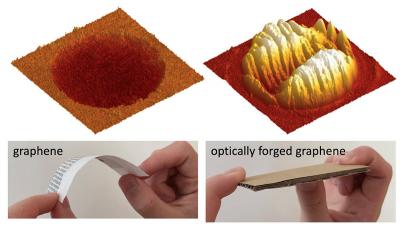Researchers at the Nanoscience Center of the University of Jyväskylä have demonstrated how an experimental technique called optical forging can make graphene ultrastiff - increase its stiffness by several orders of magnitude. Graphene typically has ultrasmall bending modulus, but the research group at the University of Jyväskylä has demonstrated how to make graphene ultrastiff using a specifically developed laser treatment. This stiffening opens up whole new application areas for graphene.
 Top - Atomic force microscopy images of the suspended graphene drum skin before and after optical forging. Bottom - analogue presentation of how a material can become stiffer when it is corrugated. (Image: University of Jyväskylä)
Top - Atomic force microscopy images of the suspended graphene drum skin before and after optical forging. Bottom - analogue presentation of how a material can become stiffer when it is corrugated. (Image: University of Jyväskylä)
The same group has previously prepared three-dimensional graphene structures using a pulsed femtosecond laser patterning method called optical forging. The laser irradiation causes defects in the graphene lattice, which in turn expands the lattice, causing stable three-dimensional structures. Here the group used optical forging to modify a monolayer graphene membrane suspended like a drum skin and measured its mechanical properties using nanoindentation.
At first, we did not even comprehend our results. It took time to digest what optical forging had actually done for graphene. However, gradually the full gravity of the implications started to dawn on us, says Dr. Andreas Johansson, who led the work on characterizing the properties of the optically forged graphene.
Analysis revealed that the increase in bending stiffness was induced during optical forging by strain-engineering corrugations in the graphene layer. As part of the study, thin-sheet elasticity modeling of the corrugated graphene membranes was performed, showing that the stiffening happens on both the micro- and nanoscales, at the level of the induced defects in the graphene lattice.
The overall mechanism is clear but unraveling the full atomistic details of defect-making still needs further research, says Professor Pekka Koskinen, who performed the modeling.
Stiffened graphene opens up possibilities for novel applications, such as fabrication of microelectromechanical scaffold structures or manipulating mechanical resonance frequency of graphene membrane resonators up to the GHz regime. With graphene's other traits like being light, strong and impermeable, one potential avenue is to use optical forging on graphene flakes to make micrometer-scale cage structures for intravenous drug transport.
The optical forging method is particularly powerful because it allows direct writing of stiffened graphene features precisely at the locations where you want them, says Professor Mika Pettersson, who oversees the development of the new technique, and continues, Our next step will be to stretch our imagination, play around with optical forging, and see what graphene devices we can make."